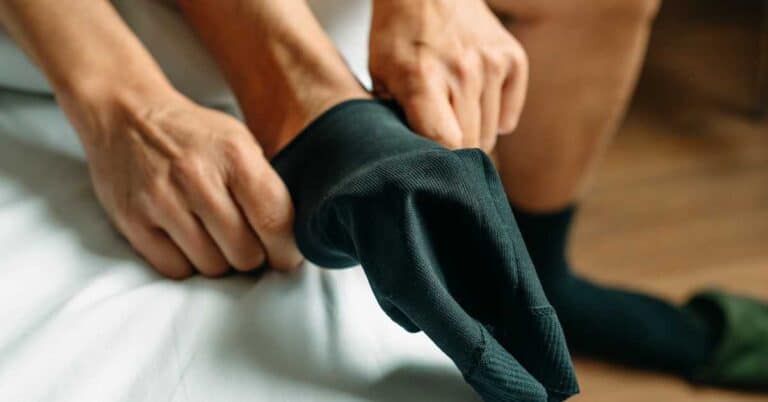Varicose veins can be a painful and unsightly problem that many people experience, especially as they age. This article will explore the use of compression socks as a potential solution to this issue. We’ll discuss how they work, their benefits and potential drawbacks, and whether they’re suitable for both men and women. You’ll also learn how to properly wear compression stockings and the best options available for those seeking relief from varicose veins.
** I may earn a commission when you purchase through a link on this page. **
Why should I consider compression socks?
Compression socks and stockings are often recommended as a treatment option for people who suffer from varicose veins and other vein-related issues like chronic venous insufficiency and deep vein thrombosis.
They work by applying gentle pressure to your legs, which can improve circulation and promote healthy blood flow. This can help alleviate symptoms associated with varicose veins, such as pain, swelling, and discomfort.
Wearing compression socks can also prevent the progression of vein disease and reduce the risk of developing spider veins or further varicose veins.
How do compression socks solve the problem of varicose veins?
Compression socks and stockings exert pressure on the leg veins, which can help improve circulation by encouraging blood to flow more efficiently back to the heart.
This can reduce swelling and the pooling of blood in the legs which often leads to varicose veins.
Compression stockings can also support the vein walls, preventing them from becoming overstretched and reducing the risk of vein damage.
How long should you wear compression socks for varicose veins?
The duration of wearing compression stockings will vary depending on the severity of your varicose veins and the recommendations of your doctor.
Some people may need to wear them daily for several hours, while others may only require them for a few hours a day.
It’s essential to follow the advice of a medical professional to ensure that you’re using compression stockings correctly and for the appropriate amount of time.
How to wear compression stockings for varicose veins
To effectively wear compression stockings, follow these steps:
Put the stockings on as soon as you wake up and before you get out of bed. This will help prevent blood from pooling in your legs while you’re lying down.
Roll the stocking down to the ankle, then pull it up over your foot and leg, making sure it’s evenly distributed and not wrinkled.
Ensure the stockings fit snugly around your legs, but not too tight. They should be comfortable and not restrict movement.
Remove the stockings before going to bed or as directed by your doctor.
Best compression stockings for varicose veins
The ideal compression stocking for varicose veins will depend on the severity of your symptoms, your personal preferences, and your doctor’s recommendations. Some popular options include:
Medical-grade compression stockings: These are prescribed by a doctor and provide a specific level of compression to meet your individual needs.
Over-the-counter compression socks: These can be purchased without a prescription and come in various compression levels, styles, and materials.
Copper Fit compression socks
Copper Fit compression socks are among the best choices for people with varicose veins and other circulation-related issues. These socks offer a unique blend of copper-infused fibers that offer natural antimicrobial and anti-odor properties and long-lasting comfort.
In addition to their superior material and construction, Copper Fit socks provide the ideal level of compression, promoting healthy blood flow and reducing swelling.
Compression Leggings for Varicose Veins
Compression leggings are another option for individuals with varicose veins. They offer similar benefits as compression socks, including improved circulation and reduced symptoms.
Compression leggings can be more comfortable and stylish for some users, making them a popular choice for both men and women.
How Effective Are Compression Socks?
Compression socks are a non-invasive treatment option for varicose veins, spider veins, and chronic venous insufficiency.
They work by applying pressure to the leg veins, promoting healthy blood flow, and reducing the risk of deep vein thrombosis.
By wearing compression stockings, you can alleviate pain, swelling, and other symptoms associated with these conditions.
Do Compression Socks Improve Circulation?
Yes, compression socks address the issue of poor blood circulation in the legs, which can lead to the development of varicose and spider veins.
By applying pressure, compression stockings help blood flow more efficiently, reducing pooling and the risk of vein disease.
Compression socks apply graduated pressure to the legs, with the highest pressure at the ankle and decreasing as it moves up the leg.
This helps push blood back toward the heart, preventing it from pooling in the veins and causing vein enlargement or blood clots.
Are Compression Socks Good for Men and Women?
Yes, compression socks are suitable for both men and women. They come in various styles, colors, and compression levels, making it easy for individuals to find a suitable option based on their specific needs and preferences.
Conclusion
Compression socks can be a beneficial solution for individuals suffering from varicose veins or other venous issues. They provide a non-invasive treatment option, promote healthy blood flow, and can help alleviate symptoms. By choosing the right compression level, fit, and style, both men and women can benefit from the use of compression stockings.

Rick Huey is a fitness writer who has dedicated his life to living an active lifestyle. With more than 30 years of experience in the fitness industry, Rick is a respected contributor for FitFab50.com, where he shares his wealth of knowledge with a wide audience. His dedication to promoting the benefits of living an active lifestyle has inspired many people to pursue their own fitness journeys with enthusiasm and dedication.

